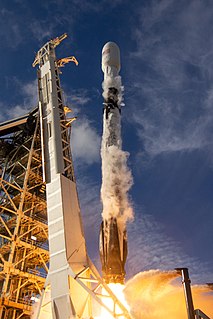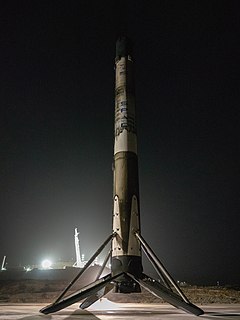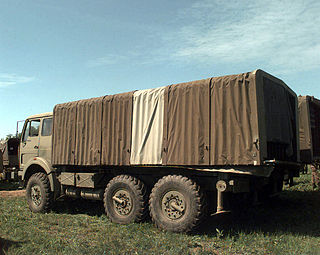This page is based on this
Wikipedia article Text is available under the
CC BY-SA 4.0 license; additional terms may apply.
Images, videos and audio are available under their respective licenses.

Evolved Expendable Launch Vehicle (EELV) is an expendable launch system program of the United States Air Force (USAF), intended to assure access to space for Department of Defense and other United States government payloads. The program, which began in the 1990s with the goal of making government space launches more affordable and reliable, resulted in the development of the Delta IV and Atlas V. Along with the newer Falcon 9, these launch systems are the primary methods for launching U.S. military satellites.

The Common Booster Core (CBC) is an American rocket stage, which is used on the Delta IV rocket as part of a modular rocket system. Delta IV rockets flying in the Medium and Medium+ configurations each use a single Common Booster Core as their first stage, while the Heavy configuration uses three; one as the first stage and two as boosters. The Common Booster Core is 40.8 metres (134 ft) long, has a diameter of 5.1 metres (17 ft) and is powered by a single RS-68 engine burning liquid hydrogen and liquid oxygen.
Orbcomm is a family of low Earth orbit communications satellites, operated by the American satellite communications company Orbcomm. As of July 2014, 51 such satellites have orbited Earth, with 50 still continuing to do so.

Falcon Heavy is a partially reusable heavy-lift launch vehicle designed and manufactured by SpaceX. It is derived from the Falcon 9 vehicle and consists of a strengthened Falcon 9 first stage as a central core with two additional first stages as strap-on boosters. Falcon Heavy has the highest payload capacity of any currently operational launch vehicle, and the fourth-highest capacity of any rocket ever built, trailing the American Saturn V and the Soviet Energia and N1.

The SpaceX reusable launch system development program is a privately funded program to develop a set of new technologies for an orbital launch system that may be reused many times in a manner similar to the reusability of aircraft. The company SpaceX is developing the technologies over a number of years to facilitate full and rapid reusability of space launch vehicles. The project's long-term objectives include returning a launch vehicle first stage to the launch site in minutes and to return a second stage to the launch pad following orbital realignment with the launch site and atmospheric reentry in up to 24 hours. SpaceX's long term goal is that both stages of their orbital launch vehicle will be designed to allow reuse a few hours after return.

SpaceX CRS-8, also known as SpX-8, was a Commercial Resupply Service mission to the International Space Station (ISS) which was launched on April 8, 2016, at 20:43 UTC. It was the 23rd flight of a Falcon 9 rocket, the tenth flight of a Dragon cargo spacecraft and the eighth operational mission contracted to SpaceX by NASA under the Commercial Resupply Services program. The capsule carried over 3,100 kilograms (6,800 lb) of cargo to the ISS including the Bigelow Expandable Activity Module (BEAM), a prototype inflatable space habitat delivered in the vehicle's trunk, which will be attached to the station for two years of in-orbit viability tests.

Falcon 9 flight 20 was a Falcon 9 space launch that occurred on 22 December 2015 at 01:29 UTC. It was the first time that the first stage of an orbital rocket made a successful return and vertical landing.

Falcon 9 booster B1019 is a first-stage reusable rocket booster for the Falcon 9 orbital launch vehicle manufactured by SpaceX. B1019 became the first orbital-class rocket that performed a successful return to launch site and vertical landing.

The SpaceX Dragon C106 is a Cargo Dragon space capsule built by SpaceX. It is the first reused SpaceX Dragon capsule to be reflown into space, having its second launch in 2017. This marked the second occasion that SpaceX launched previously spacelaunched hardware, after reusing Falcon 9 first stage B1021 earlier in 2017; this was the first time SpaceX reused a capsule. Capsule 106 was first used on mission NASA SpaceX CRS-4, and then used again for the NASA SpaceX CRS-11 mission. This reuse of the spacecraft marks a milestone in SpaceX's drive to reduce spacelaunch costs through reusing hardware.

Falcon 9 booster B1029 is a first-stage reusable rocket booster for the Falcon 9 orbital launch vehicle manufactured by SpaceX. B1029 was the second orbital-class booster in the history of rocketry to be flown again after a vertical landing. It was also the first to land without damage on an autonomous spaceport drone ship in the Pacific Ocean and to be launched from both coasts of the United States.

Falcon 9 booster B1023 is a first-stage reusable rocket booster for the Falcon 9 orbital launch vehicle manufactured by SpaceX. B1023 became the second successful return from a GTO launch, and later became the first booster to be reflown after being recovered from a GTO launch.

Falcon 9 booster B1046 is a reusable first-stage booster for the orbital-class Falcon 9 vehicle manufactured by SpaceX. B1046 was the first Falcon 9 block 5 to fly and the first to do a re-flight. It is also the first rocket to fly two GTO missions and the first orbital-class booster to fly and land three times. Notably, this booster was also the first to launch from each of SpaceX's Falcon 9 launch pads.

Falcon 9 booster B1050 is a reusable first-stage booster for the orbital-class Falcon 9 vehicle manufactured by SpaceX. It launched for the first time on December 5, 2018. The booster experienced a malfunction during reentry, resulting in the booster missing its landing at the ground pad as intended; instead performing a soft landing just offshore. The booster may be used in future SpaceX internal missions.

Falcon 9 booster B1047 is a reusable orbital-class Falcon 9 first-stage booster manufactured by SpaceX. B1047 was the second Falcon 9 block 5 to fly and the third block 5 booster to re-fly.

Falcon 9 booster B1048 is a reusable orbital-class Block 5 Falcon 9 first-stage booster manufactured by SpaceX. B1048 was the third Falcon 9 block 5 to fly and the second block 5 booster to re-fly. It became the second orbital-class booster to fly a third time.

















